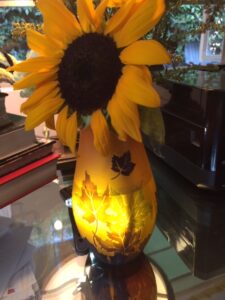 Since I wrote an article about “Real or Fake Galle” glass in 2018, I’ve received questions from all over the world. After a reader from Santa Barbara sent me an image, I decided to write an update on “Real or Fake Galle” glass. If you love a fake, and don’t pay authentic prices, go ahead! Some of the fakes are older, 1990 Taiwan, and kind of nice.
Since I wrote an article about “Real or Fake Galle” glass in 2018, I’ve received questions from all over the world. After a reader from Santa Barbara sent me an image, I decided to write an update on “Real or Fake Galle” glass. If you love a fake, and don’t pay authentic prices, go ahead! Some of the fakes are older, 1990 Taiwan, and kind of nice.
If you love Galle furniture, glass, or ceramics, go to the Musee de l ’Ecole de Nancy in France. Failing that, here’s the skinny. The average price paid for an original Galle vase is $500-2,000 with some going for MUCH more.
Lately make fakes in China and Romania. Paying a high price won’t guarantee authenticity. A good dealer will show you a catalogue of shapes, and an online service can help for free.
For the Love of Galle Art Glass
The world of art and design has loved Galle art glass for 150 years. Emile Galle (1846-1904) became the first to produce glass as art. When we say “art glass” that came from him. A polymath, brought up in his father’s art and ceramics factory, he studied botany and Islamic design. People value his creations because of his forefront in the new look—Art Nouveau. In France this featured organic shapes; flora and fauna, insects, and graceful scenic views. Young, he established his own art glass factory in Nancy, a center for glass, think of Daum Nancy Glass. He made glass for the Paris Exposition in 1878, for which he earned the Grand Prix. The value of pieces designed for shows are valued higher than the factory (industrial) vessels.
Unlike other art glass the provenance, WHO owned the piece BEFORE, doesn’t factor into the value as much as the REASON for a vessel. If Emile designed a piece for a show himself, that determines the value-enhancer. Unfortunately he died young at 58 years. After that his wife took over production, signing his name with a star. After her, the son in law, not born a Galle, produced Galle glass, and signed as his father in law. His role in the concern ran from 1904-1914. The factory closed during WWI, opening again only after 1919, closing in 1936. During this formative period in history the son in law mechanized the production.
Mechanized Galle Glass
HOW? His artists blew the glass shapes, mostly vases and lamps, into a mold. Then they layered the glass with two or three layers of OTHER colored glass. The base color was clear glass, overlaid with varying degrees of, let’s say green, then “acid etched.” The three or two-fold encased glass layers were subjected to a burin, a sharp pointer, that etched a design layer by layer. Then they sunk the vessel in a hydrofluoric bath. The longer it stayed in the bath, the deeper the design “bit.” We know this as cameo glass.
A vessel with a dark overlay of two tones, let’s say of brown, by gradations in time of the acid bath, you pulled OUT the vase when it showed a shadow of a brown, and so on. Shine a light, and you see a faint hue of what laid before. The depth of color shines in light.
Factors in the valuation of original Galle glass include condition—you can’t disguise a CRACK. Also the degree of “the artist’s hand” in the creation of the piece. Emile Galle and his talented designers often created custom works, as differentiated from the factory works, bought by the general public by the 1920s.
A feature of the Art Nouveau movement was that pieces unobtainable by the general public were commissioned for the RICH. Another major factor in value is the location of the design. If it is Lake Como, and has architectural elements, it’s worth a bunch. If the vase has flowers, what flowers were they? Galle was a botanist, so certain flowers and fauna are more valued.
Clues you have a fake:
newer reproductions will be signed with a RAISED signature. Look at the rim and feet. It should be rounded and polished, not rough and ground flat. Look at the base. It shouldn’t be too smooth or too flat. The piece should look like BLOWN GLASS.
Vases@galleartglass.com will evaluate for free, and will accept text messages at (763) 360-3608.